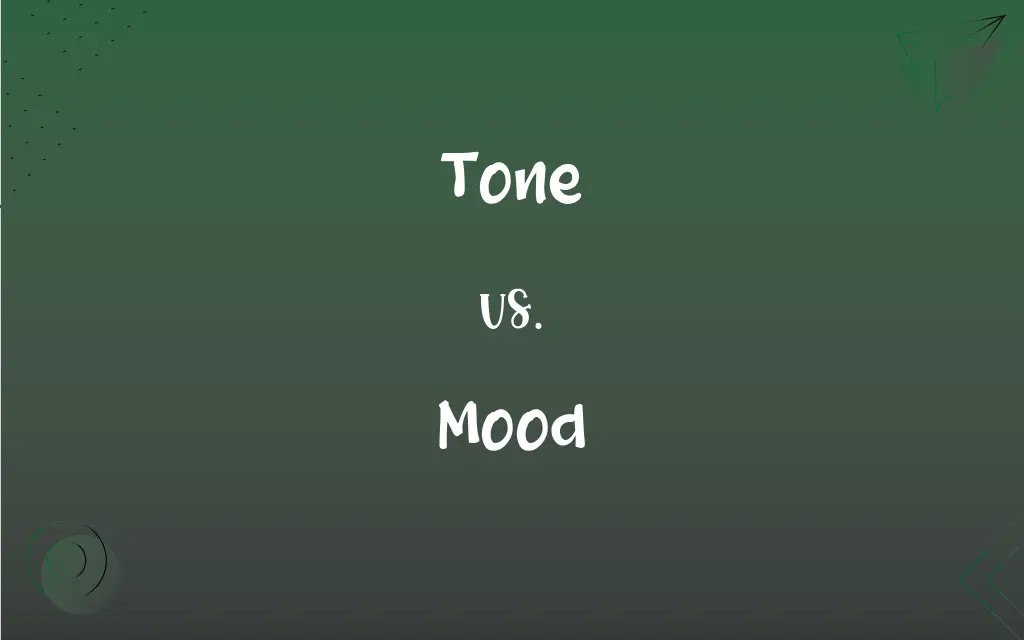Tone vs. Mood: What's the Difference?
Edited by Aimie Carlson || By Harlon Moss || Updated on October 20, 2023
Tone is the author's attitude towards a subject; mood is the emotion the reader feels from a text.

Key Differences
Tone refers to the author's attitude or feelings about the subject they are discussing. Mood, on the other hand, pertains to the overall emotional atmosphere or feeling that a piece of literature evokes in its readers. Both elements play a crucial role in storytelling, yet they serve different purposes.
In understanding tone, it's essential to look at the writer's choice of words and stylistic elements. This gives an insight into their perspective or stance on a particular topic. Contrarily, mood is not about the author's perspective but about the ambiance that is created for the audience. It's the emotional response or vibe that readers get when engaging with the content.
For instance, in a poem about a serene lake, the tone might be calm and reflective if the poet writes about personal memories related to the lake. However, the mood could be melancholic or nostalgic, depending on the imagery and phrasing used, making the readers reminisce or feel a certain way.
A writer might use a sarcastic tone to mock or criticize a subject, showing their negative or humorous view. Meanwhile, the mood of the same piece might be humorous or light-hearted, making the audience laugh or take the topic less seriously. Both tone and mood work together to deliver a piece's intended message and effect.
Comparison Chart
Definition
The author's attitude towards a subject.
The emotion the reader feels from a text.
ADVERTISEMENT
Origin
Comes from the writer's perspective.
Evoked in the reader by the text.
Elements
Word choice, sentence structure, and rhetorical devices.
Imagery, setting, and theme.
Purpose
To convey the writer's feelings or stance.
To evoke specific feelings in the reader.
Changeability
Can change frequently within a text.
Usually remains consistent throughout a narrative.
Tone and Mood Definitions
Tone
The style or manner of expression in speech or writing.
His tone in the letter was formal and respectful.
ADVERTISEMENT
Mood
A grammatical category that expresses modality.
The subjunctive mood is used for hypothetical situations.
Tone
The expressed attitude of the writer toward the subject.
Her tone in the article was defensive, advocating for her beliefs.
Mood
The emotional atmosphere produced by a work of literature.
The haunting descriptions created a mood of unease.
Tone
A quality in the voice that expresses emotion, feeling, or character.
His tone was dripping with sarcasm when he responded.
Mood
A specific state of mind or disposition.
His mood was optimistic after the good news.
Tone
A shade or quality of a color.
The tone of the painting gave it a melancholic feel.
Mood
A prevailing emotion or feeling.
The gloomy weather set a somber mood.
Tone
A particular pitch or frequency of sound.
The tone of the violin was soft and melodious.
Mood
The vibe or ambiance of a setting or environment.
The dim lights and soft music created a romantic mood.
Tone
A sound of distinct pitch, quality, and duration; a note.
Mood
A particular state of mind or emotion
News that put us in a good mood.
FAQs
How is mood created in a story?
Through elements like imagery, setting, and theme.
Can the same text evoke different moods in different readers?
Yes, personal experiences and perceptions can influence a reader's mood.
Can the tone change in a single piece of writing?
Yes, the tone can vary depending on the writer's intent in different sections.
Is mood consistent throughout a narrative?
Typically, the mood remains consistent, but it can change in response to plot developments.
What is mood in literature?
Mood is the overall emotional atmosphere or feeling evoked in the reader by a text.
How does mood affect the reader's experience?
It influences the reader's emotional response, enhancing connection and engagement with the text.
How do tone and mood relate to the theme of a story?
Tone provides insight into the author's perspective on the theme, while mood influences the reader's emotional connection to it.
Can tone and mood be the same?
They can coincide, but they serve different purposes – tone is the writer's attitude, while mood is the reader's emotional response.
How does a writer set the tone?
Through word choice, sentence structure, and rhetorical devices.
Can a single sentence have both tone and mood?
Absolutely, a sentence's phrasing can reflect the writer's attitude (tone) and evoke a feeling (mood).
Is tone always explicit?
No, sometimes the tone is subtle, requiring careful interpretation.
What's an example of a positive tone?
An optimistic, cheerful, or encouraging attitude.
What's an example of a gloomy mood?
A narrative that evokes feelings of sadness, despair, or melancholy.
What is tone in literature?
Tone refers to the author's attitude or feelings about the subject they're discussing.
Why is understanding tone important?
It provides insight into the writer's perspective and helps in grasping the intended message.
Can visuals affect tone and mood?
Yes, visuals, like illustrations in a book or cinematography in a film, can influence both tone and mood.
Why are tone and mood critical in storytelling?
They shape the reader's perception, understanding, and emotional connection to the narrative.
Are tone and mood only relevant in literature?
No, they are also pertinent in various forms of communication, including speeches, films, and music.
How can one identify the mood in a story?
By noting the feelings or emotions evoked while reading and examining elements like setting and imagery.
Can music influence the tone and mood of a narrative?
Absolutely, music can underscore or even change the tone and mood of a piece.
About Author
Written by
Harlon MossHarlon is a seasoned quality moderator and accomplished content writer for Difference Wiki. An alumnus of the prestigious University of California, he earned his degree in Computer Science. Leveraging his academic background, Harlon brings a meticulous and informed perspective to his work, ensuring content accuracy and excellence.
Edited by
Aimie CarlsonAimie Carlson, holding a master's degree in English literature, is a fervent English language enthusiast. She lends her writing talents to Difference Wiki, a prominent website that specializes in comparisons, offering readers insightful analyses that both captivate and inform.































































